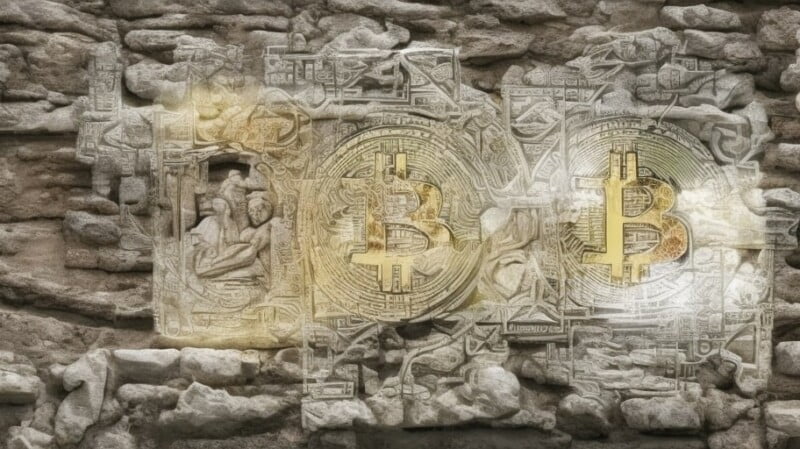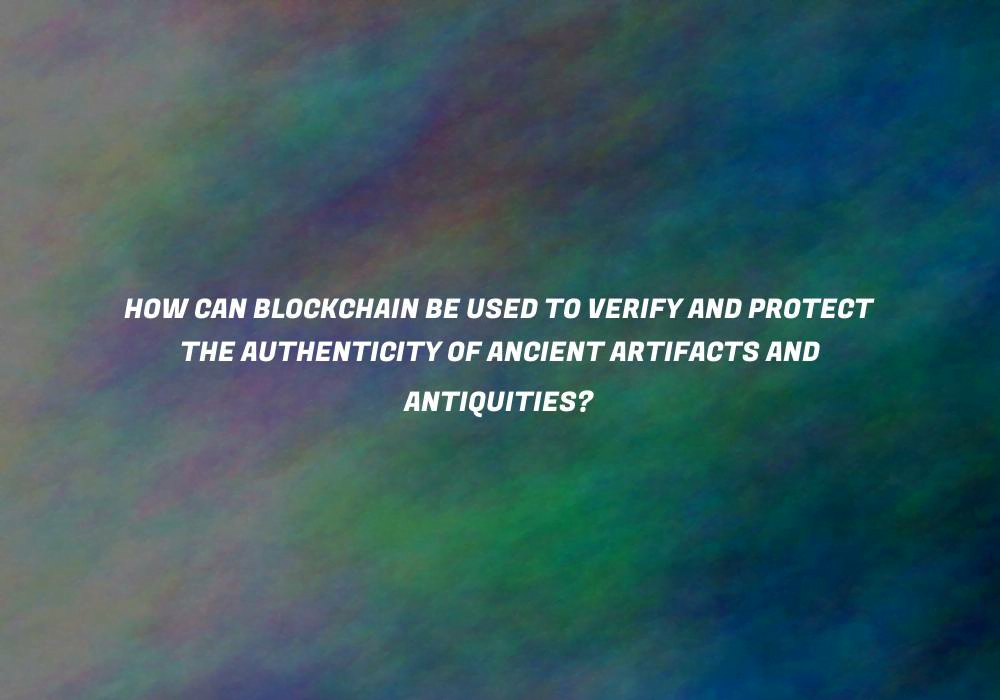Imagine a world where ancient artifacts and antiquities are not just objects of curiosity, but also a source of truth and authenticity. It may sound like something out of a science fiction novel, but with the power of blockchain technology, this could become a reality. Blockchain, the revolutionary decentralized ledger system, has the potential to revolutionize the way we authenticate and protect ancient artifacts. By providing an immutable and transparent record of an artifact’s journey throughout history, blockchain can ensure that priceless relics are not only genuine but also safeguarded from theft and forgery. In this article, we will explore the fascinating ways in which blockchain can be utilized to verify and preserve the authenticity of these treasures of the past.

Verifying the Authenticity of Ancient Artifacts and Antiquities Using Blockchain Technology
In today’s world, where the market for ancient artifacts and antiquities is booming, ensuring their authenticity has become a major concern. The rise of counterfeit artifacts and fraudulent practices has made it difficult for buyers and collectors to trust the provenance of these valuable pieces. This is where blockchain technology comes into play, offering a solution that can revolutionize the way we verify and protect the authenticity of ancient artifacts.
Benefits of Blockchain in Verification
Blockchain, known for its decentralized and immutable nature, provides several key benefits when it comes to the verification of ancient artifacts. First and foremost, it enables the creation of immutable records, allowing every transaction and ownership transfer to be securely recorded and stored on the blockchain. This means that once a record is added to the blockchain, it cannot be altered or tampered with, ensuring the authenticity and provenance of the artifact.
Furthermore, blockchain technology helps in preventing counterfeiting and fraud. By creating a transparent and traceable system, blockchain makes it easier to track the origin and ownership history of an artifact. This eliminates the possibility of fraudulent practices, as any attempt to manipulate or forge the ownership records would be immediately noticed and flagged by the decentralized network.
Lastly, blockchain enhances provenance tracking, which is crucial in the world of ancient artifacts and antiquities. Provenance refers to the documented history of ownership, custody, and location of a piece of art or artifact. With blockchain, provenance tracking becomes more efficient and reliable, as every transaction and transfer can be recorded on the blockchain, providing a transparent and trustworthy trail of ownership.
Implementing Blockchain for Artifact Verification and Protection
Building a Decentralized Network
Implementing blockchain for artifact verification and protection requires the development of a decentralized network. This means that instead of relying on a single centralized authority, multiple participants known as nodes collaborate to maintain the integrity of the blockchain. Each node stores a copy of the blockchain, ensuring redundancy and preventing a single point of failure.
By building a decentralized network, the verification process becomes more reliable and resistant to manipulation. The distributed nature of the network makes it difficult for malicious actors to tamper with the records, as any changes would need to be approved by the majority of the nodes, establishing a consensus mechanism.
Ensuring Data Integrity and Security
Data integrity and security are paramount when dealing with the verification of ancient artifacts and antiquities. Blockchain technology offers a solution to these concerns through its cryptographic techniques and consensus mechanisms.
Blockchain uses cryptographic hashes to secure the data within each block. These hashes act as unique identifiers for each block and are created by running the block’s data through a mathematical algorithm. Any alteration to the data would result in a different hash, making it immediately apparent that the information has been tampered with.
Furthermore, consensus mechanisms, such as Proof of Work or Proof of Stake, ensure that only valid and verified transactions are added to the blockchain. This eliminates the possibility of fraudulent entries or false information being incorporated into the system, further enhancing data integrity and security.
Establishing Consensus Mechanisms
Consensus mechanisms play a crucial role in ensuring the reliability and security of the blockchain network. They are used to validate and authenticate transactions, preventing malicious actors from manipulating the system.
Different consensus mechanisms can be implemented depending on the specific requirements of the artifact verification and protection system. Proof of Work is one commonly used mechanism, requiring participants to solve complex mathematical puzzles in order to validate transactions. Proof of Stake, on the other hand, involves participants proving ownership of a certain number of cryptocurrency tokens to verify transactions.
The choice of consensus mechanism should take into consideration factors such as network scalability, energy consumption, and security requirements. A well-designed consensus mechanism ensures the efficient and trustworthy operation of the blockchain network for artifact verification and protection.
Challenges and Limitations of Blockchain for Artifacts and Antiquities
Dependency on Data Accuracy
One of the main challenges of implementing blockchain for artifact verification is the dependency on accurate and reliable data. In order for the system to function effectively, the initial data regarding the ownership and provenance of artifacts must be correct and trustworthy. If inaccurate or false information is entered into the system, it can lead to issues downstream and compromise the integrity of the blockchain.
To mitigate this challenge, thorough research and verification processes should be in place to ensure the accuracy of the data recorded on the blockchain. Collaboration with experts, historians, and archaeologists can help validate the authenticity of artifacts and provide reliable information for the blockchain system.
High Costs and Technical Complexity
Implementing blockchain technology for artifact verification and protection can come with high costs and technical complexity. Building a decentralized network and ensuring its efficient operation require significant resources, both in terms of infrastructure and expertise.
The costs associated with developing and maintaining the blockchain network, as well as running the necessary consensus mechanisms, can be a barrier for widespread adoption. Additionally, the technical complexity involved in setting up and managing blockchain systems can be challenging for organizations and individuals with limited technical knowledge or resources.
However, as blockchain technology continues to evolve and mature, there are opportunities for cost reduction through scalability and improved efficiency. Collaborations with blockchain development firms and leveraging existing blockchain platforms can also help mitigate some of the costs and technical complexities associated with implementing the technology.
Lack of Universal Adoption
Another limitation of using blockchain for artifact verification and protection is the lack of universal adoption. While blockchain has gained significant traction in various industries, its adoption in the field of ancient artifacts and antiquities is still limited.
Widespread adoption of blockchain would require the participation and collaboration of various stakeholders, including collectors, art institutions, museums, and government entities. Standardization and the establishment of industry-wide protocols would be necessary to ensure interoperability and seamless integration of blockchain systems.
Efforts to promote awareness and education about the benefits of blockchain for artifact verification and protection can help drive adoption and overcome the challenges associated with its implementation. Additionally, government initiatives and regulations can play a crucial role in incentivizing organizations to embrace blockchain technology and establish a standardized framework for authentication and provenance tracking.
Future Considerations and Potential Innovations
Integration with IoT and AI
One potential future innovation is the integration of blockchain with technologies such as the Internet of Things (IoT) and Artificial Intelligence (AI). IoT devices, equipped with sensors and connectivity, can be used to track and monitor artifacts in real-time. By integrating IoT data with blockchain, a comprehensive and transparent record of an artifact’s location, condition, and ownership can be maintained.
AI algorithms can also be leveraged to analyze historical data and patterns, further enhancing the verification and protection of artifacts. AI-powered image recognition can identify and authenticate artifacts based on historical records, allowing for quicker and more accurate verification processes.
Tokenization of Artifacts
Another exciting possibility is the tokenization of artifacts using blockchain technology. Tokenization involves representing physical assets, such as artworks or artifacts, as digital tokens on the blockchain. These tokens can then be bought, sold, and traded, providing a more liquid and accessible market for ancient artifacts.
Tokenization can also enable fractional ownership, allowing multiple individuals to collectively own a piece of art or artifact. This democratizes access to valuable pieces and can potentially increase the transparency and accountability in the art market.
Collaborations with International Organizations
Collaborations with international organizations and regulatory bodies can play a crucial role in driving the adoption and standardization of blockchain for artifact verification and protection. Cooperation between countries can help establish unified protocols and regulations, bringing more credibility and trust to the authentication process.
Furthermore, international collaborations can facilitate the sharing of expertise and resources, making it easier to tackle challenges such as data accuracy, high costs, and technical complexity. By working together, governments, museums, collectors, and experts can create a global network that ensures the authenticity and protection of ancient artifacts for future generations to enjoy.
In conclusion, blockchain technology offers immense potential in the verification and protection of ancient artifacts and antiquities. Through its decentralized and immutable nature, blockchain provides benefits such as creating immutable records, preventing counterfeiting and fraud, and enhancing provenance tracking. Implementing blockchain requires building a decentralized network, ensuring data integrity and security, and establishing consensus mechanisms. However, challenges such as data accuracy, high costs, technical complexity, and lack of universal adoption need to be addressed. Future considerations include integration with IoT and AI, tokenization of artifacts, and collaborations with international organizations. By leveraging blockchain technology, we can ensure the preservation and trustworthiness of our ancient heritage for generations to come.
